
Nabe (鍋, pronounced NA-beh) is the Japanese word for a pot or pan. But it also means a one-pot dish where several ingredients are cooked together in a broth. While nabe can be cooked in the regular way on the stovetop, the most popular kind of nabe are cooked at the table on a portable burner. The quintessential image of a Japanese happy family is one that gathered around the dining table eating a nabe. (Nabe cooked at the table is also called yosenabe (寄せ鍋), which just means a nabe where the ingredients are gathered together (寄せる、yoseru).
Because a nabe is piping hot, it's a great winter meal, with very little preparation.
A lot of Japanese nabe recipes call for ingredients that are only widely available in Japan, but this is a recipe for a nabe that you can recreate wherever you are. It uses chicken and a lot of vegetables, so it's very healthy and frugal - perfect recession cooking! The only special equipment you need is a tabletop cooker of come kind, that can sustain a boiling heat. See more about tabletop cookers in the Notes at bottom.
Filed under:
japanese lighter party food winter quickcook chicken washoku nabe
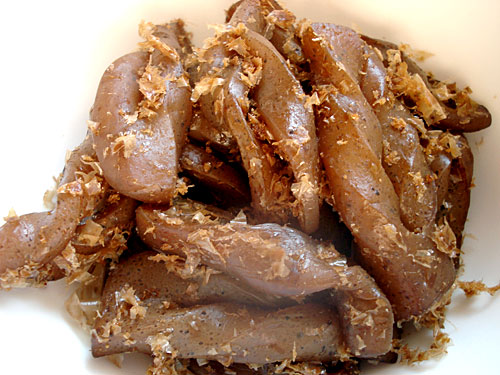
I have talked about konnyaku before, the almost zero calorie, rubbery-jellylike food that makes me really wonder at the ingenuity of people of the past. Why would they think that an almost flavorless, almost nutrient free substance would be edible?
Well, konnyaku is not about its innate flavor - it's all about texture. And since it realy has so little calories, it's a great addition to meals for the dieter, giving a feeling of fullness.
Here are a couple of easy and traditionally Japanese side dishes uses konnyaku. Konnyaku no tosani is konnyaku that is cooked in a flavorful liquid and tossed with plenty of katsuobushi (bonito flakes). __Konnyaku kinpira_ is konnyaku sautéed with sesame and chili pepper.
I tend to make konnyaku dishes when I want to really watch the calories, but still have a hearty appetite.
Filed under:
japanese lighter washoku vegetables kinpira
[From the archives: This eggplant/aubergine dish is really nice served cold, though it can be served warm too. It doesn't heat up the kitchen since it's made in the microwave (yes, the microwave, and it works great!) so it's great to make on a steamy hot summer evening, with in-season eggplant. Originally published July 2007.]
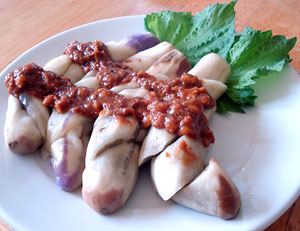
Here is another summer dish. I love eggplants (aubergines), but cooking them without using a lot of oil can be a bit tricky. I read about this method of steam-cooking eggplants in the microwave in a Japanese magazine some time ago, and ever since it's one of my favorite ways of preparing these rather spongy vegetables - they're done in just 5 minutes without heating up the kitchen, which is hard to beat on a hot summer's day. The whole dish takes less than 10 minutes to prepare.
Here they are served cold with a spicy peanut sauce, which makes it a very nice vegetarian/vegan main dish. Serve with rice or cold noodles.
Filed under:
japanese lighter vegetarian summer vegan
Incidentally, I plan to do a lot more vegetable-oriented/lighter cooking, so you'll most likely see the results of that on Just Hungry and Just Bento. This means I'm going to give the yohshoku series a rest for awhile (breaded and deep fried hamburgers tend to stick to the waistline and all.) Besides, we're finally starting to see reasonably locally grown vegetables that aren't cabbage or broccoli! This kind of thing over on Just Bento is what I'll be eating more of. I lost a bunch of weight when I couldn't eat after my surgery, but almost all of it has come right back since my appetite returned! Must. Stem. Belly rebound.
Filed under:
lighter site news

I have not featured many fish recipes here on Just Hungry. This is because at the moment I live in a landlocked country, where sea fish must be shipped in, and is expensive to boot. When I do buy some fish, I savor it as a treat. (I may be preparing myself for something that all fish eating people might have to endure soon, given the problems of overfishing.)
This is a classic miso marinade with a spicy twist. Instead of using just miso, I've added a little bit of kochujang, spicy Korean bean paste. I've used cod for this, but you could use any firm, flaky white fish instead - or even an oily fish such as salmon or swordfish. The pieces of fish should have a certain thickness, so thin fish like flounder won't do.
Filed under:
japanese lighter fish
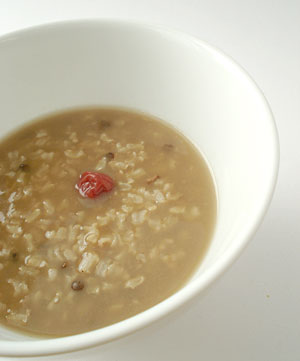 A traditional custom in Japan is to eat nanakusa gayu, or seven greens rice porridge, after the New Year's feasting period, to rest the stomach and bring the body back into balance. At any time of the year, kayu or okayu are eaten when the body is weakened by sickness, fatigue or overeating.
A traditional custom in Japan is to eat nanakusa gayu, or seven greens rice porridge, after the New Year's feasting period, to rest the stomach and bring the body back into balance. At any time of the year, kayu or okayu are eaten when the body is weakened by sickness, fatigue or overeating.
Chagayu or tea rice porridge is a speciality of the ancient city of Nara and the surrounding area. (Nara was briefly the capital of Japan in the 7th century, and is one of the most historical cities in the country). Chagayu is usually made with white rice, but I used brown rice (genmai) instead, plus a small amount of firm green puy lentils from France. The lentils are not traditional, but I like the contrasting texture.
This has been my breakfast for about a week now. It's not in the same category as eggs and bacon or a stack of pancakes, but I find my body needs something like this sometimes to bring it back into balance. It's filling and warming, yet feels very cleansing to the body. A cup of this has less than 100 calories, and is high in fiber.
Filed under:
japanese lighter rice tea vegan
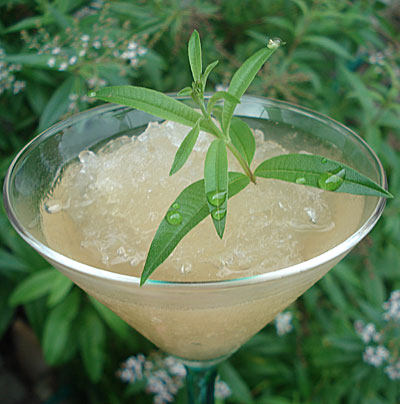
The lemon verbena plant that I planted last year and almost lost to a summer storm, is now firmly established and positively thriving. Whenever I pass it I can't resist rubbing a leaf, because it smells so wonderful.
Transferring that wonderful lemony scent to taste is quite easy - simply steeping it in some boiling water for about 10 to 15 minutes does the trick. This granita is infused with the aroma of lemon verbena, soured with a little lemon juice, and sweetened with a delicate acacia honey. Any light colored honey will work here instead. It makes a wonderful light dessert or palate cleanser, or cooling summer snack.
Filed under:
dessert lighter vegetarian sweet summer tea
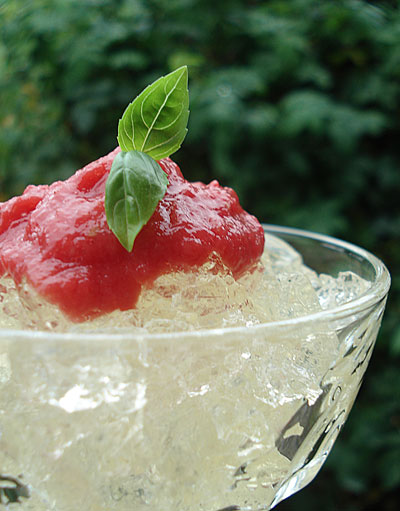
Have you ever made tomato water? It's the clear liquid strained gently from a ripe tomato, and one of the best treats of summer. When made from juicy, vine-ripened tomatoes, it has a sweet yet green-tomatoey taste that is so intense that a little goes a very long way.
Making tomato water is very simple. All it requires is a blender or food processor, a fine mesh sieve, paper towels, and patience. What you do with the resulting water is up to your imagination. Here I have added a little gelatin to make it into a tomato gelée (or, to be non-fancy, jelly). Served on top is a tomato coulis made from the pulp that is left over after the water is strained. The only heat-adding cooking involved is in melting the gelatin. It fits in well with my minimal-cooking mood this summer.
This would make a very interesting first course for a summer meal, or an amuse-bouche if served in tiny portions. It would be a great in-between courses palate cleanser too, if you are having an elaborate meal.
Filed under:
lighter vegetables summer salad low-carb
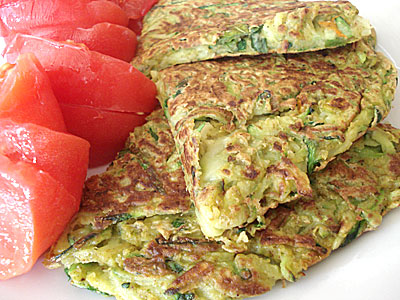
Continuing with my light and quick summer dishes:
This year we got a bit more serious than usual about our garden, and planted three zucchini plants. If you have a garden with zucchinis, you know that sometime around midsummer they start to produce babies like crazy. We've had a rather cold and rainy summer here up until now, but this week our three innocent looking zucchini plants have gone into high gear, and we're picking them as fast as we can before they turn into seedy, tasteless baseball bat sized monsters.
Zucchini pancakes are one way to use up a lot at once. This version uses chickpea flour instead of wheat flour or eggs, with a little bit of spice in it. It's great hot or cold, and is a perfect snack, side dish or complete vegan main dish, since the chickpea flour is such a terrific source of protein and carbs (nutritional info). Serve it with a salsa, curry, or just on its own. Here I just served them with some super-ripe tomato wedges. The shredded zucchini adds moisture and a rather creamy texture, which I love.
Chickpea flour is used in Mediterranean and Indian cooking. I get mine from a local Indian grocery store, where it's sold as gram flour; it's also known as besan, ceci flour, and so on.
Filed under:
lighter vegetables vegetarian summer vegan gluten-free
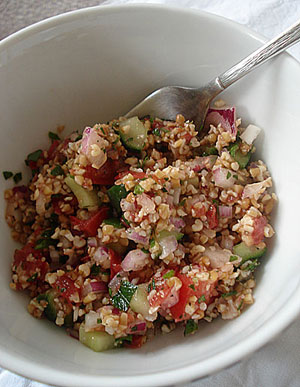
I haven't been posting a lot of recipes here recently. This is mainly because I haven't actually been doing a lot of full-on cooking, as in hauling out a lot of pots and pans and having the oven full blast and so on. It's summer after all, and I've been enjoying fruits and vegetables as close to their natural, fresh, ripe state as possible. So this week I'll be posting a few such recipes - requiring minimal active cooking, full of fresh summer vegetables, and nice to have on a warm summer day or evening.
The first one is my standard recipe for tabbouleh, with a twist - instead of using mint, I use shiso (perilla). Shiso has a slightly minty but wholly unique flavor which I really like in just about anything. I also make it with a lot less olive oil than most recipes call for, which I think adds to the fresh taste. We love to have a bowl of tabbouleh in the fridge for easy self-service lunch and snacks throughout the day - it tastes so healthy and is quite filling. It's also a great side dish for a barbeque.
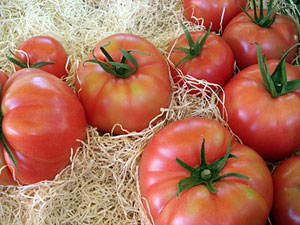
Fresh tomatoes are the key to a great tabbouleh in my opinion. You need ones that are ripe and full of flavor, yet firm. One of my favorite tomatoes at the moment are an heirloom Swiss variety called Berner Rosen - they are a rosy pink when ripe, and full of juice and flavor. (If you're in Switzerland, Berner Rosen are all over the place at the markets right now.) If you can't get hold of a good heirloom variety like this, use cherry tomatoes, which are usually reliably firm yet flavorful.
Filed under:
lighter summer vegan salad
Pages